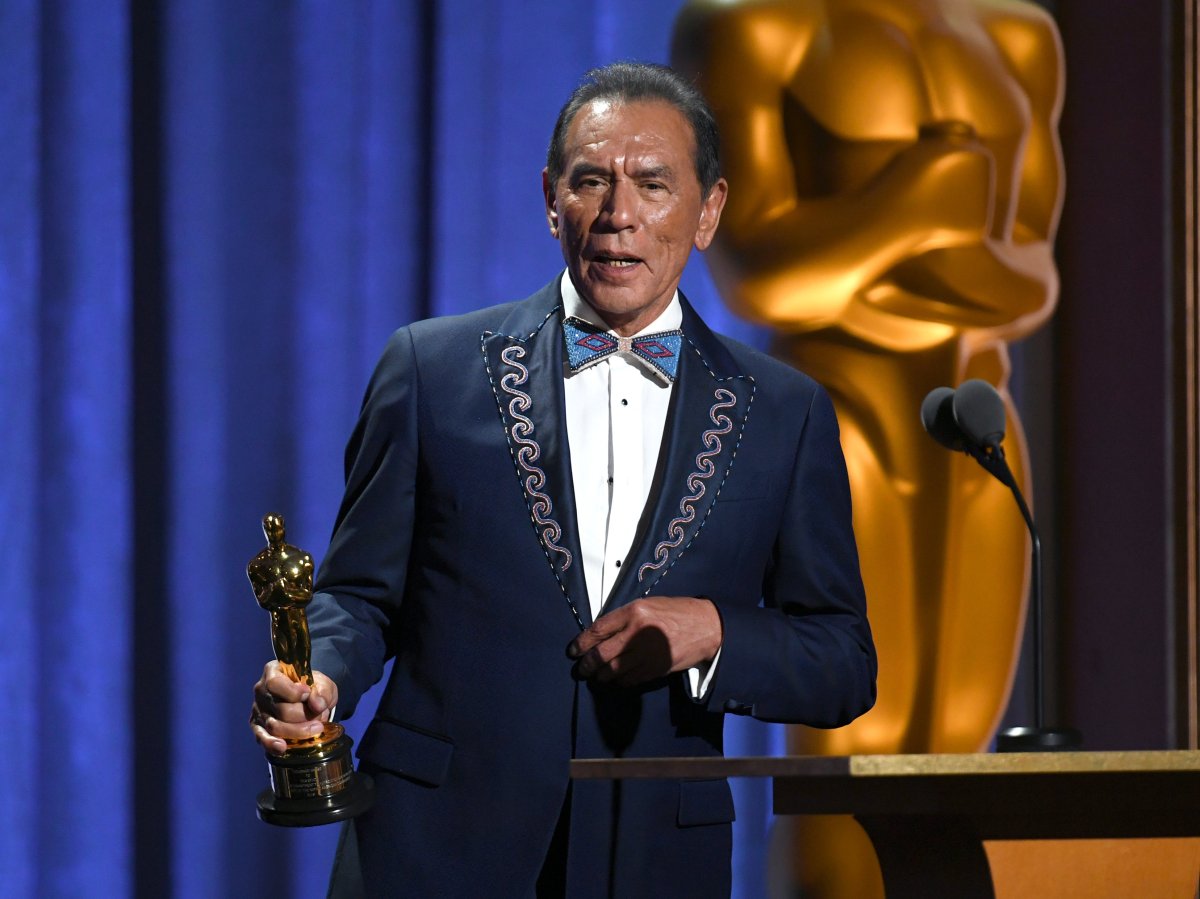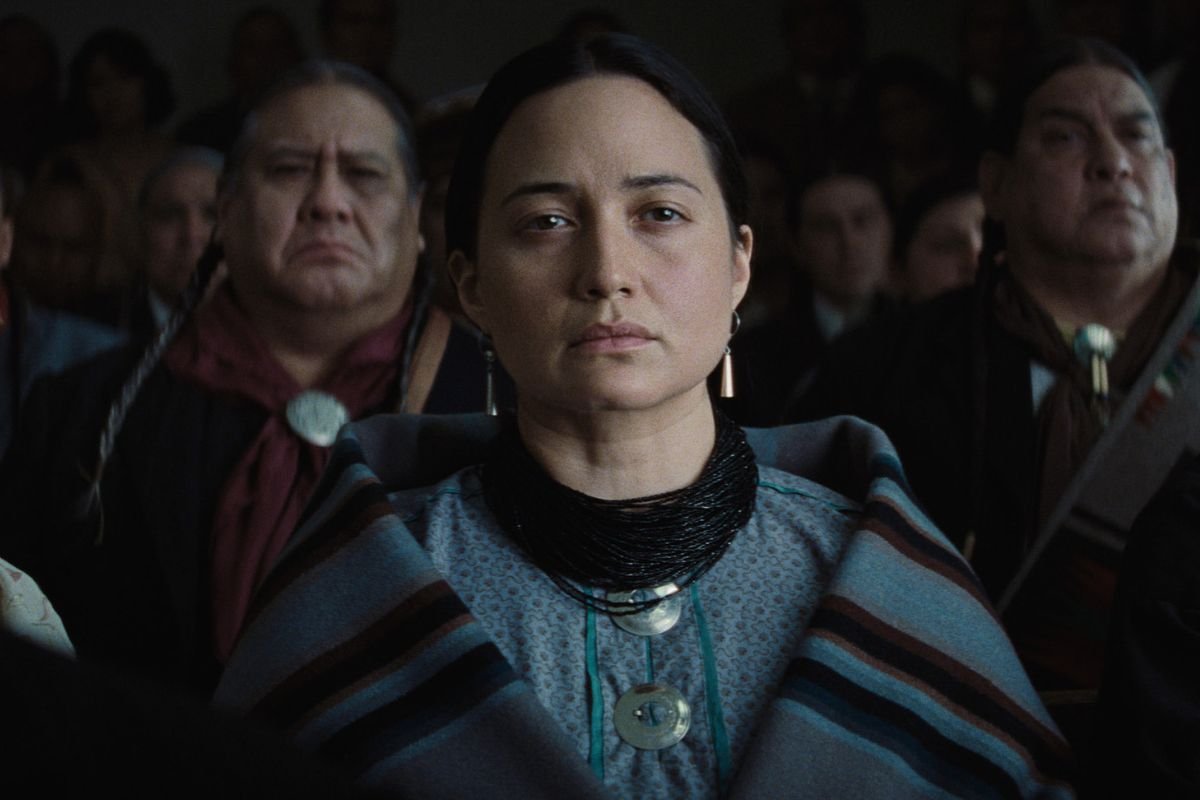On Sunday the Academy Awards missed out on the opportunity to rectify an ugly part of Hollywood’s history by awarding Lily Gladstone Best Actress for Killers of the Flower Moon.
While Gladstone, who had been the favorite heading into the ceremony, received a robust round of applause when her name was announced during the presentation of the nominees, she lost out to Poor Things star Emma Stone in one of the night’s biggest upsets.
Many believed Gladstone had been “snubbed” and it was clear Stone didn’t think she was going to win either, as cameras caught her wild-eyed look as her name was announced.
If Gladstone had won, she would have made history as the first Native American person to win an Oscar in the awards ceremony’s 96-year history. Since the Oscars began, Native Americans have frequently suffered from racist depictions with Native American actors presented with few opportunities in Hollywood.
The actor, who is from the Blackfeet Reservation, received near-universal acclaim for her performance as real-life figure Mollie Burkhart in Killers of the Flower Moon, which chronicled the series of real-life murders of members of the Osage Nation, known as the Reign of Terror. Set in 1920s Osage County, Oklahoma, the killings were part of a plot to steal the rights to their oil-rich land.
Gladstone made history when she was nominated for the award as she became the first Native American woman to be put forward. However, she was not the first Indigenous nominee for Best Actress, with previous contenders including Yalitza Aparicio for 2018’s Roma and Keisha Castle-Hughes for 2003’s Whale Rider. Both women also didn’t go on to win.
Photo-illustration by Newsweek/Getty
Newsweek emailed a spokesperson for Gladstone for comment on Monday.
Ryan Toomey, film fanatic, writer, and editor at Upbeat Geek!, said if Gladstone had won, it would have been an important milestone in film history.
“While her win wouldn’t have righted the wrongs the Oscars and the film industry as a whole have perpetuated on the Indigenous community, there was the hope that her win would have been a call for change and a shift towards a more inclusive Hollywood,” he told Newsweek.
“Lily’s clear talent coupled with the influence of Scorsese will hopefully still catalyze a more inclusive future in filmmaking, it’s time for Hollywood to acknowledge the plethora of Indigenous talent they have consistently ignored.”
Prominent Native American Actors
Unfortunately, only a handful of Native American actors have come to prominence in major roles over the years, despite there being countless Indigenous people in the industry. To help pave the way for Gladstone’s success, other Native American actors have worked tirelessly.

Kevin Winter/Getty Images
Wes Studi, a Native American man from the Cherokee Nation, has starred in successful films such as Dances with Wolves, The Last of the Mohicans and Geronimo: An American Legend. He has garnered critical acclaim and awards throughout his career and was awarded an honorary Oscar in 2019. This made Studi the first Native American as well as the first Indigenous person from North America to be honored by the Academy.
In a conversation with Newsweek, Studi said that he was “surprised” when he received a call from the Academy asking him if he would accept the Oscar, which he “accepted in a New York minute.”
“To be recognized by your peers is a wonderful thing. Coming from the Academy, it is made up of your peers and people who work in the same industry. It’s a great feeling that your efforts have not gone unrecognized,” he said.
Gil Birmingham—who identifies his father as being of Comanche descent—has had an illustrious career over the years, currently playing Tribal Chairman Thomas Rainwater in the television series Yellowstone. He is also known for his portrayal of Billy Black in the Twilight franchise, as well as for his roles in films such as Hell or High Water and Pieces of Her.
Irene Bedard was born in Anchorage and is a resident of the Alaska Native Village of Koyuk. She started her acting career playing Mary Crow Dog in the movie Lakota Woman: Siege at Wounded Knee, for which she was nominated for a Golden Globe for Best Actress in a Miniseries or Television Film. In 1995, she voiced the titular role in Disney’s animated film Pocahontas, and two years later, Bedard played the role of Suzy Song in the Native American cult classic Smoke Signals.
Newsweek emailed Birmingham and Bedard for comment on March 1.
Inaccurate Depictions in Film
The depiction of Native Americans in Hollywood has evolved, but historically they have been marred by stereotypes and misrepresentations, often depicted as caricatures.
The 2009 documentary Reel Injun is about the portrayal of Native Americans in Hollywood and discusses how before the 1930s, there was a positive representation of Indigenous people in film. The 1910 film White Fawn’s Devotion is the earliest surviving film directed by a Native American person. In 1920, an all-Native American cast made up of more than 300 Ojibwe and Kiowa tribe members starred in the 1920 silent Western Daughter of Dawn.
However, in the 1930s, white actors wearing redface began to replace Native American actors more frequently, and often the audio for Indigenous languages used in films was just English played backward. Sometimes, Native actors were asked to speak in their native language no matter what tribe they were supposed to be from in the film.
From the 1930s to the 1950s, Westerns became popular amongst movie-goers. These films often reinforced stereotypes of “savage” warriors attacking white settlers. One example of this is the film Northwest Passage, in which Native Americans are portrayed as villains. For many years, Native Americans were viewed as the evil foil to cowboys.
Some films during the 1960s and 70s attempted to portray Native Americans in a more sympathetic light, using the “noble savage” trope. Native American characters were romanticized as wise, spiritual, and in harmony with nature. However, they were still often portrayed as exotic or mystical figures rather than fully developed individuals.
In the 1970s and beyond, there was a shift towards more nuanced portrayals of Native Americans in film. Revisionist Westerns like Little Big Man and Dances with Wolves attempted to provide more accurate and empathetic representations of Native American culture and history. However, while Dances with Wolves was hailed by mainstream audiences and provided jobs for many Lakota actors, it has also been cited as a return to the “white savior narrative.”
“Historically, Native Americans have frequently faced reductions to stereotypes in film. For years, cinema often presented them as savage, be they noble or antagonistic depending on plot necessity,” Tim Stevens, a writer with Connecticut College and freelance film and television critic, told Newsweek.
“Over the years, the portrayal of Native peoples grew more sympathetic, although often no less stereotypical. Even modern-day stories with Native Americans tend to invoke some mysticism. Additionally, they are often supporting players to white leads, there to offer advice or crack jokes but never to take the spotlight. Even in films supposedly specifically about Native Americans and their history, Dances with Wolves, for instance, the story ends up being more about a white person’s reaction to Native Americans than the Native peoples themselves.”
First Nations Canadian arts journalist Jesse Wente—a self-described “Ojibwe dude”—spoke to Newsweek about how the portrayal of Native American people has changed over time.

AppleTV+
He explained that Hollywood is “America’s myth machine” that lies to audiences about the origins of the United States. Wente said that this is what resulted in First Nations people being portrayed as “villains, antagonists and foils for the settler colonial project of Manifest Destiny.”
“Hollywood has used movies to lie to the world about America’s founding and the violence of colonialism. It has sought to erase us through the stories it tells, just as colonialism has through violent dispossession. Storytelling has always been a way for colonialism to erase its own impacts and to ease the consciousness of the settlers who must occupy stolen Indigenous lands taken by violence and feel entitled to do so,” Wente said.
“We have seen some slight progress in this depiction of First Nations in Hollywood since the Civil Rights era began in the 1960s. This is largely due to an increased presence of First Nations people within the industry itself beginning to make work that corrects the historical record willfully obscured by Hollywood. As our participation grows we have seen this continue with more dignity brought to bear on our representation on screen, along with more authenticity and truth.”
George Patient, a film, TV and game writer at Merch Mates, agreed that the portrayal of Native Americans in film has become more accurate but improvements still need to be made.
“While early films like The Vanishing American relied on simplistic archetypes, more recent productions, such as Smoke Signals and The Fast Runner, demonstrate a shift towards authenticity, with Native Americans controlling their narratives. Despite this progress, a 2017 USC study highlighted a persistent lack of representation, with Native American characters almost invisible in top-grossing films,” he told Newsweek.
Looking to the Future
Despite Gladstone’s loss, things seem to be changing—but there is still a way to go.
While Killers of the Flower Moon was lauded by the industry, it divided Indigenous viewers. According to The New York Times, some critiqued the fact that the movie was told from a white man’s perspective and said it lacked sufficient context about the U.S. government’s complicity in the murders of members of the Osage Nation.
However, Wente said that even if Gladstone had won, he didn’t believe it would change the industry.
“As we have seen with other milestone wins, including when Graham Greene was nominated back in the 1990s, nothing much changed. We have not seen some great growth in the production of Black or Hispanic films just because actors from those communities get an Oscar,” he explained.
“If those filmmakers gain access, it’s always because they worked incredibly hard to break through and the industry sees commercial potential in them; it’s not because the industry opened up to accept them.”
That being said, Studi told Newsweek he has seen the industry change since he first became an actor.
“There are so many more Natives involved in the business these days, unlike when I first got started in the business. There’s been a surge of Native people involved in all aspects of the production of film and we’re beginning to, as we had done for many years, tell our own stories in our own way,” he said.
“We’re also building our own film and television industry. That’s been a great thing to have happen at a time when we want to push on our own abilities to act in the sovereign way, in terms of providing and telling our own stories. I think this is the real highlight of it all and I think Lily Gladstone is an avatar of that movement now.”
There have been improvements in the industry over the years, with organizations such as Illuminative increasing the visibility of Native peoples. There are also a variety of grants and programs offered by groups such as Vision Maker Media, the Nia Tero Storytelling Fellowship, and Native American Media Alliance Programs.
There are a range of talented Native Americans inspiring the next generation of filmmakers and actors, Gladstone included. As she said in her Golden Globes acceptance speech: “This is for every little rez kid, every little urban kid, every little Native kid who has a dream, who is seeing themselves represented and our stories told by ourselves, in our own words, with tremendous allies and tremendous trust with and from each other.”
Uncommon Knowledge
Newsweek is committed to challenging conventional wisdom and finding connections in the search for common ground.
Newsweek is committed to challenging conventional wisdom and finding connections in the search for common ground.


